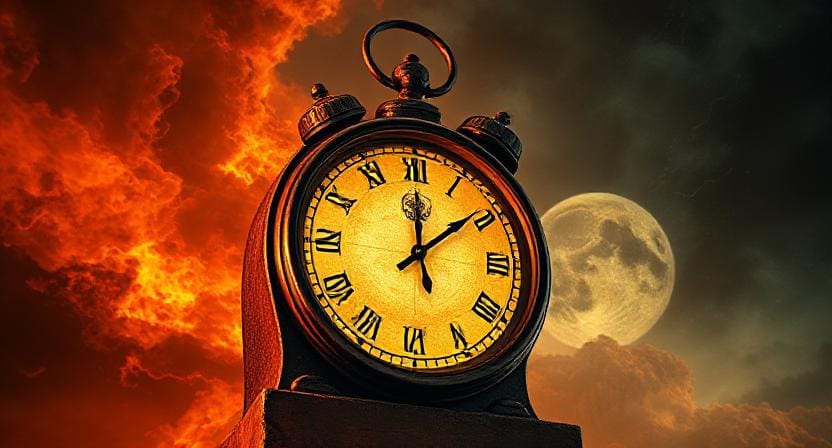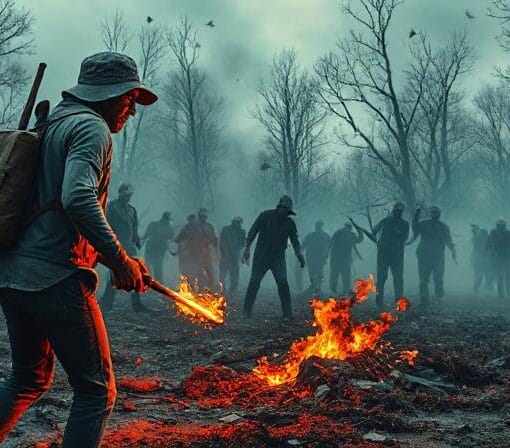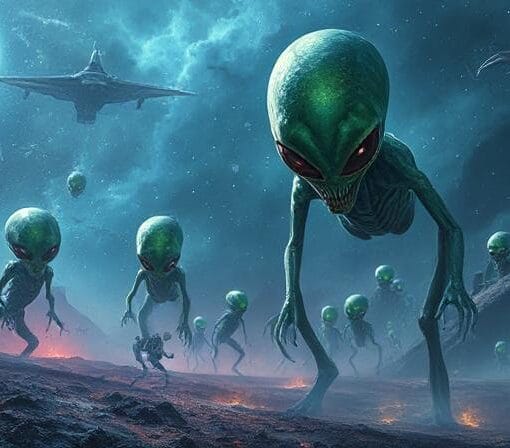Please Note: This post may contain affiliate links. If you click one of them, we may receive a commission at no extra cost to you. As an Amazon Associate, I earn from qualifying purchases.
Top Takeaways and Key Concepts
- Stay informed about global threats like war, climate change, and AI to understand humanity’s true risks.
- Support collaboration among nations to reduce nuclear weapons and promote peace through diplomacy and awareness.
- Take individual action by conserving energy, reducing waste, and encouraging responsible environmental practices.
- Use the Doomsday Clock as motivation, not fear—see it as a reminder to act, not panic.
- Promote dialogue and unity by discussing global issues and inspiring collective problem-solving and resilience.
Summary of This Article
The Doomsday Clock is a symbolic warning created by scientists to show how close humanity is to global catastrophe. Set at 90 seconds to midnight, it reflects the dangers of war, climate change, and emerging technologies. Though alarming, it’s not meant to cause panic—it’s a call for awareness, action, and unity. History shows we can move the clock back through cooperation and smart global choices. Every effort, from policy to personal change, brings hope and proves that while time may be ticking, humanity still holds the power to turn it back.
Short Video Version of this Article
Let’s talk about this clock that says the end of the world is near. It’s not a scary grandfather clock from a haunted house, no. It has been ticking for 77 years, and it’s not counting down to your birthday celebration.
This clock is here to remind us that we are very near to making the Earth a post-apocalyptic wasteland. You know, the kind of place where tumbleweeds roll through the streets and everyone is trying to avoid zombies. Oh no!

The Bulletin of the Atomic Scientists, the people who built the atomic bomb, placed the clock at 90 seconds to midnight this year. That’s quite close! You are completely right if you think that sounds horrible.
Not a lot of time, ninety seconds. It’s like when you’re in a hurry to accomplish a project and the deadline is right there. Imagine racing through a dark area, praying the zombies don’t reach you when you’re only trying to get some food.
There are a lot of feelings that come up when it’s this close to midnight. It can be scary. But instead of hiding beneath a blanket, maybe this is a moment for us to all come together. We should all hope for a better future and do everything we can to keep this clock from striking midnight.
So, let’s remain up to date, get our munchies ready, and be the main characters in our own post-apocalyptic drama. We have to stick together when the clock is ticking!
The Doomsday Clock was also at 90 seconds last year. Why? Russia invaded Ukraine, which made people think horrible things about nuclear weapons being taken out of storage. Not the best thing to talk about over coffee.
We were at 100 seconds to midnight from 2020 to 2022, which was a few years ago. It didn’t seem as important. You know you have a big test coming up next week, but you keep repeating, “I’ll study later.” But what about now? Things don’t appear to be getting better.
It’s not a fancy gizmo that counts down the time. It’s more like a giant flag that says, “Hey, we should really talk about what’s going on.” It reminds us to work together and think on the future, even when circumstances are tough.
It feels like we’re all in this giant boat when I think about it. The water is also a little rough. But we can still guide it to safer shores. Even merely talking about these issues over a cup of coffee might make us feel less alone.
So let’s talk about how we feel, keep our spirits up, and maybe even have a snack while we deal with the uncertainty. Because it’s much better to face the future united than alone.
What’s Keeping Us So Close to the Edge?
 You’d think with everything going on, we’d be moving that hand back a bit, but nope. The decision to keep the clock at 90 seconds this year has a lot to do with the usual suspects: the ongoing mess in Ukraine, the Israel-Gaza conflict, and the ever-looming threat of a nuclear arms race. Oh, and don’t forget climate change—the gift that keeps on giving.
You’d think with everything going on, we’d be moving that hand back a bit, but nope. The decision to keep the clock at 90 seconds this year has a lot to do with the usual suspects: the ongoing mess in Ukraine, the Israel-Gaza conflict, and the ever-looming threat of a nuclear arms race. Oh, and don’t forget climate change—the gift that keeps on giving.
We’ve just lived through the hottest year on record, and Mother Nature isn’t pulling any punches with floods, fires, and other disasters that seem to be auditioning for the next big disaster movie.
Plus, with all the buzz about artificial intelligence, there’s a whole new set of questions about whether these robots are going to help us out or just join the list of things trying to end the world as we know it.
Wait, What Exactly Is This Clock?
So, if you’re wondering, “Who thought up this Doomsday Clock?” let me fill you in. It was created by some really smart scientists from the Manhattan Project. Yep, that’s the one about the atomic bomb, way back in 1947.
At first, it was all about nuclear threats. You know, like keeping an eye on BIG bombs. But then in 2007, they decided to throw climate change into the mix. Because, why not add more layers to this already tricky cake, right?
Over the past 77 years, the time on the clock has jumped around. Sometimes it goes forward, sometimes back. Other times, they just leave it where it is, like they did this year. It’s like they’re trying to read the mood of the world, but I sometimes wish they’d just take a vacation instead.
The clock is mostly set by a group of super-smart folks who really know their stuff. We’re talking nine Nobel laureates here, so this isn’t just a random guess. It’s serious stuff, but they do their best to make it understandable for the rest of us.
Every tick of that clock reminds us we’re all in this together. It can feel overwhelming, but chatting about it helps. We can still laugh, share snacks, and support each other even when things feel heavy.
But Is This Clock Really Helpful or Just a Gimmick?
Some people could say, “Isn’t this clock a little too dramatic?” And yes, it’s not ideal. It puts all types of risks—nuclear war, ecological calamity, AI taking over—on one timeline and mixes them all together.
But it nevertheless serves as a strong reminder that we’re living on the edge here. It’s like having a smoke detector that goes out not only when there’s a fire but also when your house is ready to fall down and your fridge is running out of ice cream.
What Will Happen When the Clock Strikes 12?
The clock has never struck midnight, and we all hope it never does. When the clock strikes midnight, it implies we’ve really fouled things up, like nuclear war or climate disruption that is so bad it can’t be fixed. If that happens, we probably won’t even notice when the clock strikes midnight since we’ll be too busy cleaning up the mess.
So, how right is this thing, anyway?
Let’s be clear: the Doomsday Clock isn’t a science that you can rely on. It’s more about getting people to talk about and pay attention to some really serious issues, including climate change and nuclear disarmament. It’s accomplishing its job if it gets people talking.
And it looks like it works. Do you remember the climate negotiations in 2021? Boris Johnson, who used to be the Prime Minister of the UK, couldn’t help but talk about the Doomsday Clock when he talked about climate change. So, yes, people are paying attention.
Can We Turn Back the Clock?
Here’s the good news: the clock’s hands can actually move back. Yep! It’s happened before. Remember 1991? The U.S. and Soviet Union signed a treaty to cut down on nuclear weapons. The clock went back to 17 minutes before midnight—like, ages in Doomsday Clock time.
Then there was 2016 when the Iran nuclear deal and the Paris climate accord happened. That helped push the clock back to three minutes before midnight. So, it can be done!
But let’s be real. Turning back time on the clock won’t be easy. It takes real effort from everyone. Not just the bigwigs in government but from all of us regular folks too. Every little thing we do counts. Cutting down on driving, using less energy, or just chatting about these issues with family and friends helps. We’re the ones who got ourselves into this mess, so it’s on us to help fix it.
So there you have it. Our countdown to doom, but with a sprinkle of hope. The Doomsday Clock isn’t just about doom and gloom; it’s like a wake-up call. Let’s hit the snooze button on this before it’s too late. We can do this together. Just a little effort can go a long way.
Featured Snippet: The Doomsday Clock symbolizes how close humanity is to a global catastrophe. Set at 90 seconds to midnight, it highlights threats like war, climate change, and artificial intelligence, urging people to act collectively with awareness, unity, and responsibility to create a safer and more sustainable future.
Frequently Asked Questions
What is the Doomsday Clock?
The Doomsday Clock is a symbolic measure created by scientists to represent how close humanity is to a global disaster caused by nuclear conflict, climate change, or emerging technologies.
Who manages and updates the Doomsday Clock?
The Bulletin of the Atomic Scientists, which includes Nobel laureates and global experts, sets and updates the clock each year based on current world events and threats.
Why is the clock currently set at 90 seconds to midnight?
The clock remains at 90 seconds due to ongoing global conflicts, nuclear tensions, environmental crises, and rapid technological risks like AI development.
Can the Doomsday Clock move backward?
Yes, the clock can move backward when nations work together on peace treaties, climate action, or disarmament efforts that reduce global threats and build cooperation.
Is the Doomsday Clock meant to scare people?
No, it’s not about fear. The clock is designed to raise awareness and motivate collective action to prevent disaster and promote a stable global future.
How accurate is the Doomsday Clock as a prediction?
The clock isn’t a scientific prediction but a symbolic warning that reflects expert analysis of global risks and encourages public discussion about real-world issues.
What actions can individuals take to “turn back the clock”?
People can help by conserving energy, supporting environmental policies, spreading awareness, reducing waste, and promoting peace through dialogue and community engagement.

Kevin Collier is a seasoned outdoor enthusiast and writer for Trekbug.com, specializing in outdoor adventures, survival strategies, and prepping insights. With a deep love for nature and a commitment to self-sufficiency, Kevin empowers readers to embrace the wilderness confidently. He shares valuable tips, practical techniques, and inspiring stories, helping both novice and experienced adventurers develop essential skills for surviving and thriving in the great outdoors.




